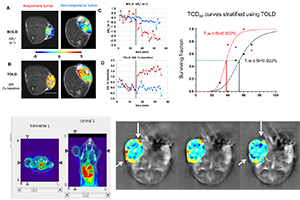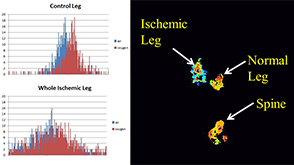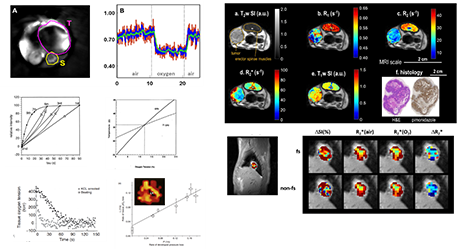Research Projects
Check out the program's latest research endeavors:
Development of Novel Contrasts Agents and Non-invasive Imaging Biomarkers

A vast array of potential reporter molecules exists based on many diverse imaging modalities: we have investigated methods of assessing pO2 and/or hypoxia, pH and specific enzyme activity (β-galactosidase). Exogenous reporter molecules may offer very specific insight into tissue properties, while interrogation of endogenous signal can be entirely non-invasive. For example, oxygen can serve as an effective theranostic: an oxygen gas breathing challenge can indicate levels of hypoxia based on BOLD/TOLD MRI or MSOT and potentially modify level of oxygenation to enhance treatment response.
Hypoxia - Characterization and Exploitation

An adequate supply of oxygen is vital to tissue health; notably ischemia leading to hypoxia is the central cause of damage in myocardial inaction, stroke and peripheral artery disease. Meanwhile hypoxia tumors are known to be more aggressive and resists therapy, particularly radiation. Thus, we are interested in developing effective biomarkers of hypoxia and tailoring therapy to the oxygen status of tissues.
Peripheral Artery Disease

Peripheral arterial disease (PAD) is a severe impairment of arterial vessels resulting in obstruction of normal blood flow in the legs, leading to acute and/or chronic lower limb ischemia, and subsequently high morbidity and mortality rates. In collaboration with teams at UT Arlington (Nguyen) and Penn State (Yang) our long-term goal is to develop novel degradable dual-modal imaging nanoparticles (DINPs) to specifically deliver therapeutic reagents that provide cell protection and facilitate formation of blood vessels de novo at ischemic sites, while allowing detection of the NP location and monitoring of their therapeutic effectiveness for PAD treatment. The polymer scaffold material is new, and it provides both fluorescent and deep tissue photoacoustic imaging opportunities to detect the in vivo distribution of these NPs and to allow their therapeutic assessment. MSOT also reveals tissue vascular oxygenation.
Evaluation of Novel Therapeutics and Treatment Strategies

Vasculature is particularly amenable to selective treatment being readily accessible to systemic drugs. In some cases it exhibits rapid acute response to intervention, which may be observed using diverse imaging technologies. In long term collaboration, we have been evaluating novel vascular disrupting agents being developed by Professors Pinney d Trawick of Baylor University. A recent collaboration with Professor Zhang of UTD evaluate novel heme targeting agents. Imaging is particularly effective at assessing dynamic changes which may be pertinent to combined therapy, e.g., optical timing and dosing of chemotherapy plus radiation therapy.
Technology Development

As new technologies become available with novel instruments, reporter agents and processing algorithms we seek to enhance the data content and accessibility. Image quality is particularly susceptible to motion and may be enhanced through various techniques such as accelerated acquisitions, co-registration and filtering.
